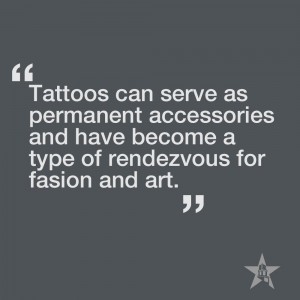Tattoo. The word strikes fear into the hearts of some nervous suburban mothers whose minds are flowed with visions of hardened sailors and ruthless convicts. Or does it? The stigma that once surrounded tattoos and those who wear them is shifting slowly but surely following the radical revolution that has been taking place in tattooing.
 Recently I watched Eric Schwartz’ documentary Tattoo Nation in which he traces the evolution of the art of tattooing beginning at the time when having a tattoo meant one of two things: you had either been in prison and served hard time, or you had been a sailor in the Navy. Prison tattooing is really where the art of tattooing as such took off. Inmates had to use handmade needles and were forced to work in the limited color palette of black and gray, with ink made of ash and soap. However it was the diversity and the lack of cohesion in prison tattooing that gave leverage to the rise of individuality in tattooing. The black and gray palette and fine line work of prison tattoos became the foundation for expansion in the world of the art of tattooing. In Tattoo Nation, Charlie Cartwright and Jack Rudy are inspired by the techniques they saw nurtured behind prison walls, and in conjunction with their creativity, they became the pioneers of the tattoo industry as we know it today.
Recently I watched Eric Schwartz’ documentary Tattoo Nation in which he traces the evolution of the art of tattooing beginning at the time when having a tattoo meant one of two things: you had either been in prison and served hard time, or you had been a sailor in the Navy. Prison tattooing is really where the art of tattooing as such took off. Inmates had to use handmade needles and were forced to work in the limited color palette of black and gray, with ink made of ash and soap. However it was the diversity and the lack of cohesion in prison tattooing that gave leverage to the rise of individuality in tattooing. The black and gray palette and fine line work of prison tattoos became the foundation for expansion in the world of the art of tattooing. In Tattoo Nation, Charlie Cartwright and Jack Rudy are inspired by the techniques they saw nurtured behind prison walls, and in conjunction with their creativity, they became the pioneers of the tattoo industry as we know it today.
Even as the craft began to expand, fear and judgments still lingered, as many were unable to erase the negative ties etched in their minds between tattoos and prison. Yet as tattooing kept gaining traction, artists expanded their clientele from ex-cons and sailors to include anyone who walked in off of the street. As their clientele expanded, so did the artist’s repertoire. Legends like Ed Hardy, “the Godfather of modern tattoo,” both helped to lay the foundation for Traditional tattoo art and introduced the art of Japanese style tattooing to America.
Slowly the revolution of individuality in tattooing and its expansion as an art form has further introduced the idea of self-expression to the world of tattooing. Self-expression in tattooing is akin to self-expression in any other type of art medium, the only difference is that this canvas is living and breathing. The stigma against tattoos has started to fade as they’ve become much more than designators for sailors and ex-cons. Their ability to be individualized has made them ways to capture meaning and significance in a person’s life. In a digital age, tattoos are a concrete form of expression; they cannot be lost in the recesses of the Internet or deleted, rather the art becomes a true part of the person and their identity. Alongside the deep significance and personal meaning they can (and typically do) carry for people, tattoos can also serve as permanent accessories and have become a type of rendezvous for fashion and art. Although perhaps still odd to many in the art world, tattooing has the potential to be an expressive and beautiful art form that can be shared as easily as a handshake.
The revolution in the tattoo industry has been accompanied (begrudgingly so) by a corresponding shift in attitude amongst the general public toward the tattooed world from a negative one, to one which is more accepting and understanding, and perhaps bordering on supportive in some cases. However it’s no secret that the professional world is one of the last holdouts. A scenario that is quite common today is that of worried parents all but threatening unemployment and homelessness if their children get tattoos in the hopes of scaring them into making “smarter” decisions. However, while this argument still carries some weight today, it is essential that this bias in the professional workforce be put to rest. Using the presence (or visibility) of tattoos as an excuse not to hire an applicant gives the owner the ability to take away the worker’s bodily autonomy, which is unacceptable in this day and age. Not to mention that discriminating based on the presence of tattoos is akin to discriminating based on haircut or even birthmarks. However, an allowance should be made if the art is unfit for the workplace (such as explicit words and images).
Tattoos no longer necessarily scream “rebellion” and “questionable character;” rather they’ve become an artistic way to define oneself. In light of the evolution of tattooing from a pseudo-art past time for sailors and convicts to a modern art form, our society should reflect a corresponding change toward appreciation of art instead of judgment.
